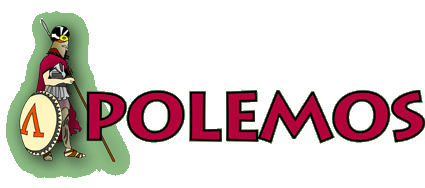POLEMOS - FRANCO
PRUSSIAN WAR - HISTORICAL BACKGROUND
The Franco-Prussian war has a relatively low profile
among wargamers. This is a shame, as despite it's relatively short
duration the period has a lot to offer. The following is a short
introduction to the events of the war and the armies involved.
Origins
Relations between France and Prussia began to worsen after the
Austro-Prussian war of 1866. Tensions really began to rise however,
when France and Prussia clashed over a possible ascension, from
the Catholic branch of the Hohenzollern royal family, to the vacant
Spanish throne.
France opposed this move and delivered an ultimatum to King Wilhelm
I of Prussia “the candidacy must be withdrawn;” which
he did. However aiming to humiliate Prussia further, Napoleon
III of France also wanted Wilhelm to apologise and withdraw any
possible future claim to the Spanish throne. King Wilhelm refused
during an unofficial meeting with the French ambassador as he
had not yet been informed officially of the request. Chancellor
Bismarck leapt at the chance of to promote the unification of
Germany. He published an account of this meeting and embellished
the encounter by pronouncing that the meeting was more heated
than it really was. A Communiqué was released to the German
public whose opinion went exactly the way Bismarck had intended
to.
The French reacted with outrage; Napoleon III declared war on
Prussia and effectively all of the states of Southern Germany.
On the 28th July 1870, Napoleon III headed for Metz to assume
command of the Army of the Rhine. On August 2nd, Frossard's 2nd
Corps and Bazaine's 3rd Corps crossed the German border; they
had invaded.
Summary
The French mobilisation plan, at the time of invasion, was still
in progress and building to a peak and gathering its forces. While
the French Mobilisation began well, it inevitably slowed down
and the reserves generated would take a long while to reach the
front. On top of this the French defensive strategy would cost
them dearly in the field. The Germans however had very quickly
mobilized and deployed their armies within a few weeks; the speed
and success of the German mobilization and campaign were due the
extensive use of trains, energetic Prussian leadership and the
wholesale use of modern artillery.
This speed of concentration surprised the French and eventually
led to them losing large areas of Eastern France after a number
of strategically decisive German victories. The Prussian response
to the French invasion was swift. The 1st and 2nd Armies (Northern
spearhead) and the 3rd Army (Southern) were let loose on the rather
surprised enemy.
The French responded to this action by immediately creating a
front 180 km long from Strasbourg to the Luxembourg border. On
August 4th, the Prussian 3rd Army attacked the Southern part of
the line, and immediately gained Wissembourg from the French and
captured the city of Wörth two days later. After a week of
fighting, the French Rhine Army's Southern line (I and V French
Corps commanded by MacMahon) retreated West under intense Prussian
pressure. This French retreat occurred on the same day as the
French Northern forces (II, III and IV Corps, commanded by Bazaine)
were beaten by the Prussians led by von Moltke near Saarbrucken,
and retreated to the fortress at Metz. This retreat led to the
most important battles of the war.
The Prussian 1st Army followed the French retreat and captured
the city of Pange, 15km from Metz, while the 2nd Army maneuvered
around Metz and captured key cities west of Metz by August 16th.
After the battles of Mars la Tour and Gravelotte the encirclement
of Metz effectively trapped Marshal Bazaine and his 130,000 French
soldiers.
60 km South the Prussian 3rd Army was capturing town after town
and the French Rhine Army (I and V Corps), just kept on retreating
and eventually reached Chalons heading south west, while the Prussians
drove west and lost contact. The 120,000 strong French army of
the Rhine (I, VII, XII Corps) now led by Mac-Mahon and Napoleon
III, began marching from Chalons in an attempt to rally behind
the besieged army at Metz over 130 km to the East. This left V
and VI Corps behind to protect Chalons. However the Prussian 3rd
Army was performing excellently and in 3 weeks they covered over
300 km, intercepted the French and for three days (August 29th
to 31st) battled to force the French to fallback on Sedan. The
Prussians then created a 4th Army from the IV and XII Corps of
the 2nd Army, and marched them to the South of Sedan, while the
3rd Army dug in to the North.
On September 1, 1870, the Prussians began the siege of Sedan.
French inaction allowed the Germans to reinforce and completely
encircle the City. The Prussians launched a massive offensive
on September 2nd forcing Napoleon to quickly surrender with his
remaining 83,000 French troops leaving the Prussians to begin
their march on Paris. Effectively this ended the imperial reign
of Napoleon III and led to the French government declaring the
establishment of the Third Republic on September 4th, 1870.
By September 19th, the Prussians were laying siege to Paris and
this turn of events brought the French government to the negotiating
table, but as it turned out the Prussians would settle for nothing
less than Alsace and Lorraine. After the failed peace negotiations
Gambetta began organizing a new army in the countryside, where
ordinary French citizens and soldiers were beginning to fight
the Prussians in a guerilla war. Initially they began achieving
somewhat better results than they had with a conventional army
commanded by weak leadership.
Bazaine surrendered the fortress of Metz, along with 140,000 soldiers
on October 27th. Paris held out for several months more while
making many attempts to break the siege with supporting armies,
but the Prussians were gradually establishing control over the
French forces everywhere Paris finally gave in on January 28,
1871.
The end of the Franco-Prussian War came with The Treaty of Frankfurt,
signed on the 10 May 1871. In hindsight this was the first Franco-German
war, as the French aggression towards the Germans had effectively
caused the German states to unite.
This unification delivered a permanent break in the relations
between Germany and France which eventually led Europe to the
First World War in 1914.
The effects of the war also led countries previously without a
General Staff or a system of conscription to adopt them and develop
the use of trains, telegraph systems and logistics. These were
all destined to become standard military practices.
The French Army
At this time was made up of almost 500,000 regulars; these were
a mixture of veterans from other French campaigns in the Crimea,
Italy, Algeria and Mexico. They could also call up a large reserve
to supplement this figure.
Infantry were equipped with the Chassepot breech-loading rifle,
one of the best rifles in, at this time, in the world. The artillery
was equipped with muzzle-loaded, rifled guns and in addition to
this the army was also equipped with the mitrailleuse “machine
gun”. These were mounted on artillery gun carriages and
grouped into batteries in the same way as the artillery batteries.
In reality the French Corps and Army Reserve Artillery was badly
mishandled and most of it never reached the battlefield so this
resource was never really tapped by the French command.
The army was led by Napoleon III with Marshals Bazaine, MacMahon
and Trochu among others.
This is the organisation of a typical French corps at the start
of the war.
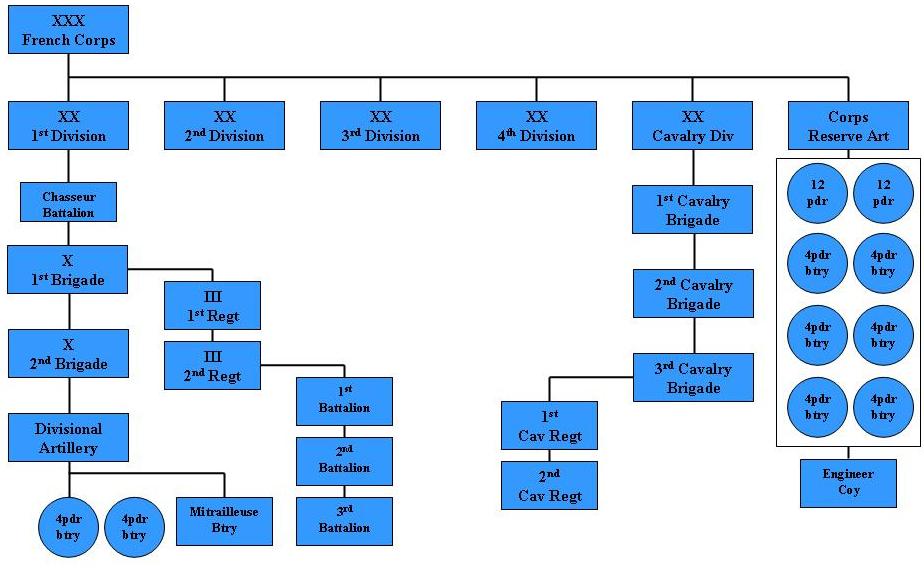
This is the organisation of a typical French Cavalry Reserve Division
at the start of the war.
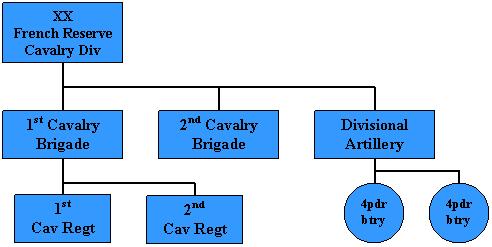
The Prussian Army
Made up of conscripts, “Compulsory service for all men of
military age”, Prussia and its allies could mobilise over
a 1 million soldiers. The infantry was still using the Dreyse
rifle or "needle-gun".
The Prussian artillery batteries were by this time using the rifled
Krupp breech-loading cannon these fired contact-detonated shells
had a realistic battlefield range of 3,500 meters and very fast
rate of fire when compared to muzzle loading cannon. Also the
tactical flexibility of the Prussian artillery to respond quickly
by supporting the front line troops in assaults and creating grand
batteries very quickly highlighted the fragility of the French
defensive doctrines.
The Prussian army was commanded by Field-Marshal von Moltke and
his General staff and whilst France had a strong standing army,
the Prussians needed weeks to mobilise their conscript armies.
This gave the French an initial advantage of numbers and experience.
However French tactics emphasised the defensive use of the Chassepot
rifle and an entrenched style fighting; this would prove to suit
the German tactics of encirclement and using artillery as an offensive
weapon as much as possible.
This is the organisation of a typical Prussian corps at the start
of the war.
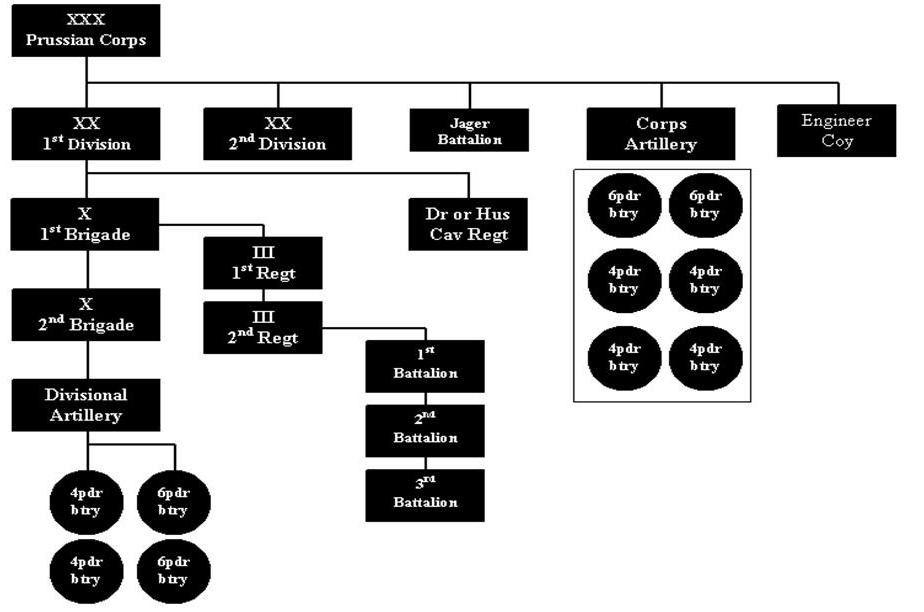
This is the organisation of a typical Prussian Cavalry Reserve
at the start of the war.
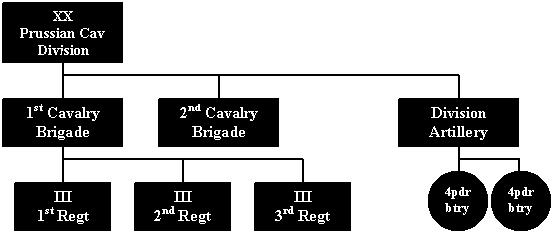
The Army Organisations
This is a guide to the make up of the armies involved. As you
can see the make up of the different armies were very similar.
The Prussians were very fluid with their Army organisations,
taking various Corps and attaching them to different armies as
strategic or organisational stresses arose.
Whereas the French organisations tended to be kept together; however
as the war progressed the French were forced into a more fluid
approach to organisations as casualties mounted.
|
